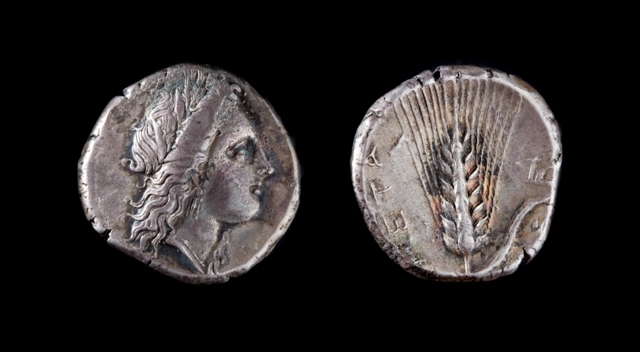Metapontum, Silver Stater
Dublin Core
Title
Metapontum, Silver Stater
Subject
Metapontum, Lucania (Italy) Silver Stater, ca. 325-300 BCE.
OBVERSE: Head of Demeter, wearing necklace and triple-pendant earring and crowned by a wreath of three barley ears and two pairs of leaves, facing right. Signature under chin: “DA(I)”.
REVERSE: Seven-grained ear of barley in center with a leaf curving to the right. Above the leaf is a small plow, below it part of the mint supervisor's mark, “M(AX)”. In left field, inscription "META," abbreviation for METAPONTIWN (= Metapontion, "of the Metapontians"). There is a die flaw in the upper left awns of the ear of barley.
OBVERSE: Head of Demeter, wearing necklace and triple-pendant earring and crowned by a wreath of three barley ears and two pairs of leaves, facing right. Signature under chin: “DA(I)”.
REVERSE: Seven-grained ear of barley in center with a leaf curving to the right. Above the leaf is a small plow, below it part of the mint supervisor's mark, “M(AX)”. In left field, inscription "META," abbreviation for METAPONTIWN (= Metapontion, "of the Metapontians"). There is a die flaw in the upper left awns of the ear of barley.
Description
Metapontum (Greek: Metapontion) was an Achaean colony on the Italian coast. Located between two rivers, the area was famed for its rich croplands. They were even able to afford sending a “golden harvest,” probably golden replicas of sheaves of barley, to the sanctuary at Delphi (Strabo 6.264). Golden sheaves of barley, represented by the grain on the REVERSE of this coin, were symbolic for the city, signifying the wealth and richness of their grain. Accordingly, the grain acted both as the city’s badge and became the standard REVERSE illustration for coinage as early as the fifth century BCE.
Demeter, the grain goddess who also held domain over farming, was a very appropriate patron for the area and her bust often graced the OBVERSE of their coinage. This particular engraving may be inspired by the head of Arethusa engraved by Kimon in fifth century BCE Syracuse.
Demeter, the grain goddess who also held domain over farming, was a very appropriate patron for the area and her bust often graced the OBVERSE of their coinage. This particular engraving may be inspired by the head of Arethusa engraved by Kimon in fifth century BCE Syracuse.
Source
Gift of James and Aneta McIntyre, Hallie Ford Museum of Art, Salem, OR. 2006.010.019
Date
330-300 BCE
Rights
Hallie Ford Museum of Art
Format
2.150 cm
7.700 gr
7.700 gr
Language
Greek
Type
Coin
Coverage
This item can be viewed on Hallie Ford Museum of Art's website.
Citation
“Metapontum, Silver Stater,” Hallie Ford Museum of Art Exhibits, accessed December 26, 2025, https://library.willamette.edu/hfma/omeka/items/show/71.
